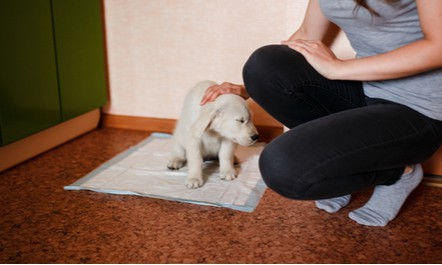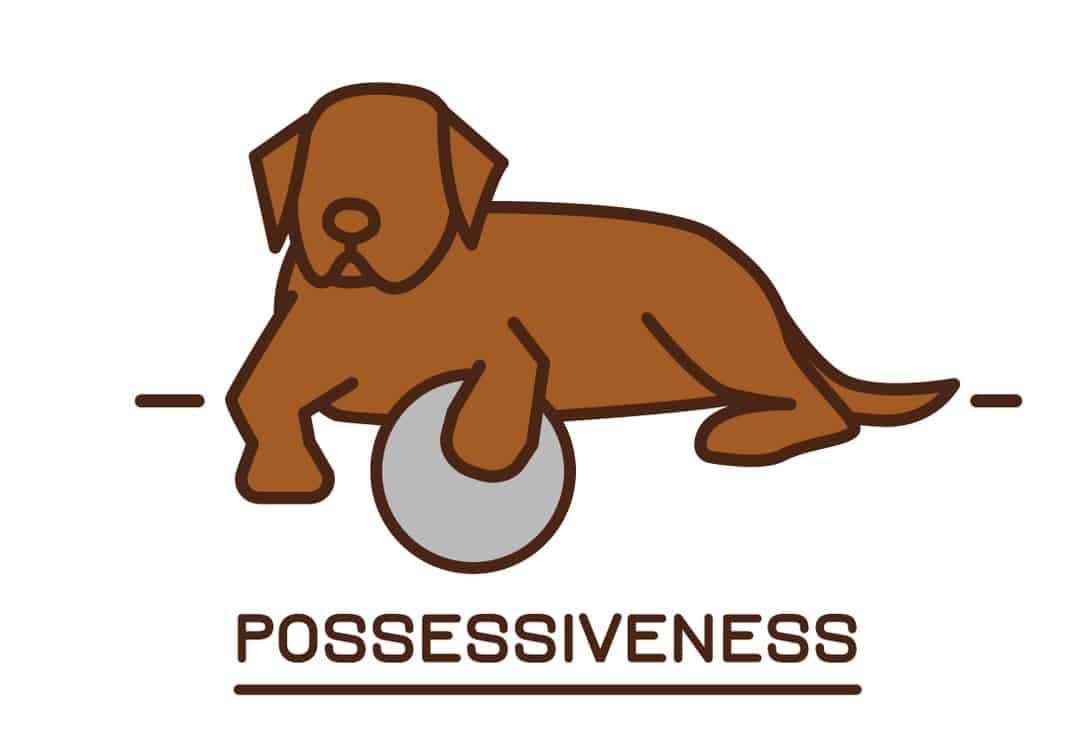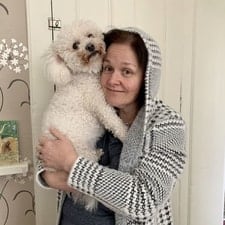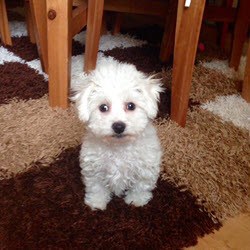Three months is equal to four human years for a small dog
The same stage is equal to three human years for a large dog
Puppies age at the same speed in their first year and then the process slows down
At three months you can do daily training and housebreaking should become easier
Puppies grow quickly. A three-month old pup is equal to around four human years. If you know a few kids of that age, you’ll know they’re into everything.
Puppies are much the same.
Three months are equal to around 12 to 13 weeks. That much is easy to figure out. However, the three-month marker is an important one in a puppy’s life. The more you know about it, the easier you’ll find it to cope with this time if you’re taking on a new puppy.
I’ve done plenty of research on this topic. I’ve also had personal experience – we adopted a Bichon Frise puppy called Freya several years ago. If memory serves, we got her at nine weeks old. Boy was she cute!
The picture at the top of this article was taken by me on the day we brought her home – such a pickle!
I’ve provided a list of pointers revealing what you should expect from a three-month old puppy. I’ve also listed solutions to help you navigate each experience safely and as easily as possible.
Understanding how a puppy’s age compares to a similar stage in humans is important. It helps you figure out what you are dealing with. I’ll go into this in more detail here.
The equation of one dog year to seven human years is incorrect
It’s a statement you have probably heard before. It isn’t accurate though. In its first 12 months of life, your puppy is going to go through a similar amount of growth as a human would in their first 15 years of life. After that, the equivalent age slows down.
Where did the seven-year ‘rule’ come from? No one is sure, although an article on the American Kennel Club website suggests it has been around since the Fifties. It’s an easy way to compare dogs to humans, but it doesn’t cover everything.
Size matters when working out the equivalent human age of your three-month-old puppy

Do you have a small, medium, large, or giant breed of dog? The answer influences their equivalent human age.
Larger dogs take a bit longer to reach maturity, so while a small breed of dog would be calculated at around four human years at three months, a large breed would be the equivalent of just three years. They catch up later in life though.
Use an online calculator or converter to work out your puppy’s age
These calculators are designed to take the guesswork out of figuring out how old your puppy would be if they were a human.
The idea is to use two or three dropdown menus to select how old your dog is and what size they are. There is no need to select a breed. Most calculators provide the option to choose from small, medium, and large. Some also have giant or extra-large as options.
At two months old, your pooch will be equal to a child aged two years and eight months. No wonder they are a handful! They then advance by the equivalent of 18 months over the next four weeks until they reach that all-important three-month puppy stage.
At 12 weeks, a puppy is old enough to have the DHPP vaccines
The first shots a puppy has are at around six to eight weeks of age. Since puppies aren’t ready to leave their mother until at least eight weeks old, the breeder should have got these sorted out by the time you pick up your puppy.
The next set of shots occurs at between 10 and 12 weeks old. So, if you don’t meet your new puppy until they are around 12 weeks, check whether the breeder has got these done yet or not. They should be able to give you a record of the shots your pup has had.
The recommended shots your puppy should have at this stage cover these diseases:
- Distemper
- Adenovirus
- Parainfluenza
- Parvovirus
According to the American Kennel Club (AKC), there are several optional vaccinations that can also be given at this time. These are:
- Influenza
- Lyme disease
- Bordetella
- Leptospirosis
Those are optional because the recommendations can depend on the activities your dog is likely to get up to. For example, you may plan to take your puppy to the local woods, which could increase the likelihood of Lyme disease. Living in an area where deer and sheep are common would also increase this.
Best advice: Take the advice of your veterinarian to determine whether any of the optional shots would be advisable for your puppy to have.
A pup of this age needs lots of training

It’s your responsibility to make sure your puppy is adequately trained from an early age. You may find your pup learns some things quickly, while other things take longer.
If you think about the amount a toddler learns in a short space of time, you’ll see why puppies are a handful at this age. Going from two years eight months to a four-year-old child – wow, kids learn plenty. A puppy goes through that same stage in a month.
Freya was always very eager to learn. She was happy whenI praised for getting something right. Even today, she loves training.
She’s five years old now, and I started challenging her to find the treat underneath one of three yogurt pots. I put one underneath the middle pot, then switch them around like a magician does with those red balls.
She’s good at finding them and then waiting for the next challenge. It helps keep her mentally focused and entertained – especially when the weather is awful or too hot for us to go out.
The American Kennel Club has a list of five essential training activities you should begin doing with your puppy almost as soon as you get them home.
These include sit – something Freya got right within seconds. Even now, you don’t need to ask her to do it. She just knows. Laying down took longer, but she’s good with it now.
A 12-week old puppy should learn through reward-based training

Never punish your pup for getting something wrong. Instead, wait until they perform whatever action you are trying to get them to do, such as:
- Use the right place for toileting
- Sitting when asked
- Walking on a leash
- Following another command
Whenever they do what you are training them to do, reward them with plenty of praise and a treat. After a while, we found we didn’t always need the treats. Freya responds positively to praise too, especially if we give her a fuss. She’s proud of herself when she gets something right – always has been.
Start socializing your puppy from this age too
Once your pup has had their second set of vaccinations, they’re ready to meet the world. You need to wait a couple of weeks after the shots before you take them out. By this point, we were more than ready to start taking Freya for short walks. She could start experiencing the world beyond our house and yard.
While it is great to have access to a safe yard that is fenced in for them to play in, they should still go out for daily walks. This gives them a chance to meet other dogs, so they can get used to saying hello and learning how to behave around them and other people of all ages.
If you live somewhere quiet, where you don’t see too many dogs, you can always enroll in a puppy socialization class. These are offered by dog trainers and by some veterinary practices. If your vet doesn’t offer these, they can usually recommend someone locally who does.
Puppies need exercise, but you shouldn’t walk too far at three months old
They’ve only got little legs at this stage, and while you’re probably eager to start enjoying some walks together, you’ll need to build up to that slowly.
I found several short walks per day worked best. Three 10-minute walks would be ideal. It also gives you a chance to go on three different routes. This allows them to:
- See and experience more
- Meet more people
- Be exposed to new situations
- Meet different dogs
A three-month old puppy should only be left alone for short periods

It’s best to build up slowly, too.
We had a large crate for Freya, and we put her in there, so she was safe, and then walked around the block. We were only out for about 10 minutes, and we never made a fuss about going out or coming back.
We gradually increased the time we were out until we could go out for an hour or two at most.
You can also invest in an interactive puppy camera. This is set up and connected to your smartphone, so you can watch what they are doing when you are out. You can also interact with your dog by talking to them and even rewarding good behavior with a treat.
Adult dogs can be left alone for longer, but you need to build up to this. If you work all day and you want to get a puppy, you need to work out who will be able to visit and check on them when you are out.
Housebreaking gets easier from around 12 weeks old
Puppy pads, ah yes, I remember those!
Be prepared and make sure you have lots of puppy pads available for toilet training, which begins in earnest at this stage. Also recommended is a specially formulated spray that gets rid of the odor caused by puppy urine when they have accidents around the house.
And they will have accidents.
Freya was reasonably good at toilet training, but it did take a while. Patience is the best tool to have, but those puppy pads and the stain and odor removal spray were great too.
Simply using a wet cloth or any other disinfecting spray won’t do. You may think it’s fine, but your puppy will likely still smell where they last went. If your puppy can smell their scent, they’ll go there again.
Not ideal if that happens to be your rug, floor, or anywhere other than your puppy pad if you’re using these for training.
From the second you get your puppy, make sure you establish a toileting routine. This is what we did, from nine weeks when we got her, through 12 weeks and beyond:
- Set up an area with puppy pads in place
- Take her to the area whenever she woke up in the morning or after a nap
- Encourage her to go after eating or drinking
- Take her after playing
- Lots of praise and a training treat (a small one, so as not to overfeed) whenever she went ‘potty’
We didn’t immediately train her to go outside because our garden is frequented by foxes and cats that we knew could be carrying all kinds of diseases. She hadn’t had her second set of jabs when we got her, so to be safe, we stuck to potty pads indoors.
Once she got the hang of them, we moved them closer to the door and then outside. It took a while for her to be 100% trained, but we got there in the end.
Teething should have begun by the three-month stage
The main phase of teething takes around four weeks or so from this age. Be ready for your puppy to try and chew you too! Anything and everything they can get their mouths on is fair game at this stage.
Have plenty of chew toys ready, so you can redirect your puppy to those whenever they start chewing something they shouldn’t. Praise them when they chew the right things, but remember not to punish them if they chew the furniture or you.
I found that teething rings and similar items that were designed to be frozen were ideal for this stage. They are safely sealed but contain a liquid that freezes and remains cold for some time. They help reduce any discomfort your pup might feel as their baby teeth fall out, and the new ones start pushing through.
Puppies of this age can be possessive

We stopped this early by taking toys away from Freya whenever she was playing with them. Just for a few seconds, then we praised her and gave them back. We did the same with food. She never became possessive at all.
A simple trick, but one that could help enormously.
Three months is a major stage in the life of a puppy, regardless of breed. Yet it is also a time to bond with your pup and to enjoy learning together. There will be challenges, but you’ll realize how rewarding it is when they get the hang of things that you’re teaching them. Together, you’ll both learn plenty.

Sources:
http://www.endmemo.com/medical/dogyear.php
https://www.akc.org/expert-advice/health/puppy-shots-complete-guide/
https://www.thatmutt.com/2016/06/19/how-far-can-i-walk-my-puppy/
https://www.akc.org/expert-advice/training/teach-your-puppy-these-5-basic-commands/
https://www.rover.com/blog/uk/how-often-should-i-walk-my-puppy/
https://www.akc.org/expert-advice/puppy-information/3-months-old/
https://www.thesprucepets.com/puppies-three-to-six-months-4570930
https://www.akc.org/expert-advice/training/leaving-puppy-alone/
https://tractive.com/blog/en/good-to-know/tips-for-leaving-your-dog-home-alone
https://www.pedigree.com.au/puppies/puppy-age-calculator/
https://www.almanac.com/content/dog-age-chart-dog-years-human-years

